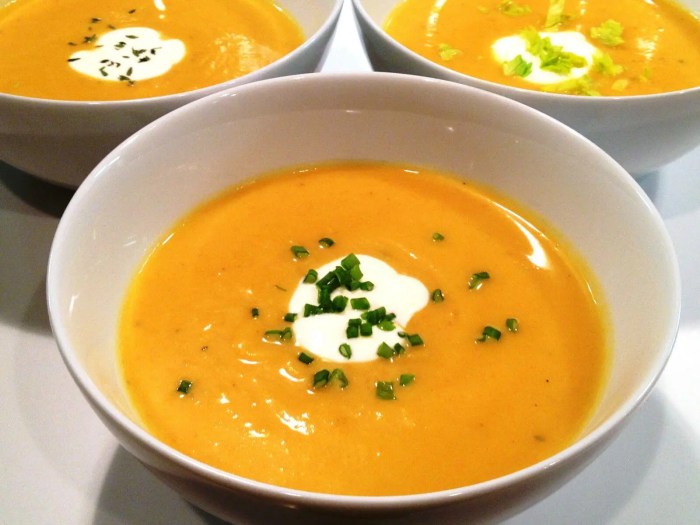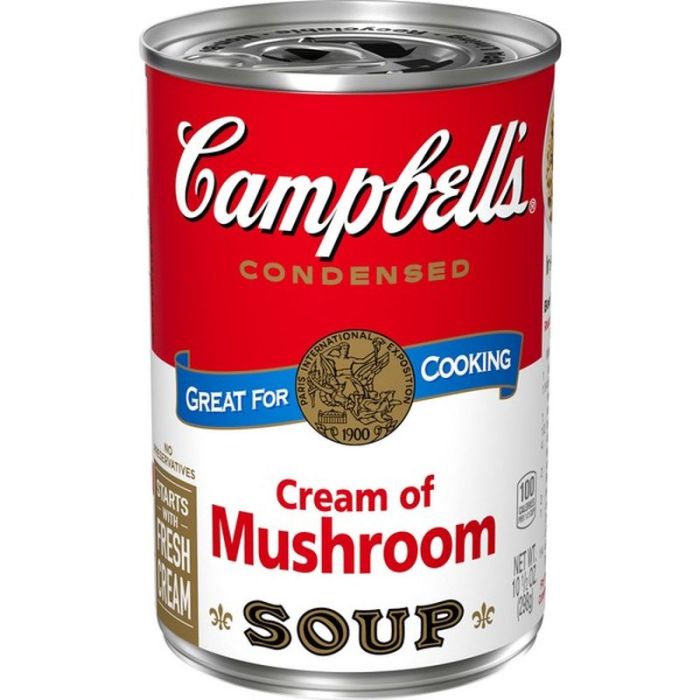Butternut Squash Soup: A Culinary Journey: Butternut Squash Recipe Soup
Butternut squash recipe soup – Butternut squash soup, a comforting and flavorful culinary creation, offers a delightful blend of sweetness, creaminess, and subtle spice. Its vibrant orange hue and rich, velvety texture make it a visually appealing and satisfying dish, perfect for chilly evenings or special occasions. Beyond its delicious taste, butternut squash itself boasts an impressive nutritional profile, making this soup a healthy and wholesome choice.
Introduction to Butternut Squash Soup, Butternut squash recipe soup

Source: tmbi.com
The appeal of butternut squash soup lies in its versatility and ability to satisfy both the palate and the soul. Its naturally sweet flavor profile lends itself to a variety of culinary interpretations, from classic and simple to modern and innovative. The creamy texture, achieved through careful cooking techniques, provides a luxurious mouthfeel that is both comforting and indulgent. Furthermore, butternut squash is a nutritional powerhouse, packed with vitamins, minerals, and antioxidants, adding to the soup’s overall health benefits.
Butternut squash, a winter squash variety, is rich in beta-carotene (converted to vitamin A in the body), vitamin C, potassium, and fiber. These nutrients contribute to improved vision, immune function, and digestive health. While pinpointing the exact origin of butternut squash soup recipes is difficult, its popularity likely stems from the squash’s long history in culinary traditions across various cultures.
Over time, recipes evolved, incorporating diverse flavors and techniques to create the many variations we enjoy today.
Recipe Variations: Classic vs. Modern
A classic butternut squash soup typically features a simple combination of roasted or sautéed butternut squash, vegetable broth, and perhaps a touch of cream or coconut milk for richness. Modern interpretations often incorporate unexpected flavors and textures, such as spices like curry or harissa, or additions like roasted apples or toasted pepitas for added complexity. The classic version emphasizes the inherent sweetness of the squash, while modern versions often aim for a more balanced or even spicy profile.
Here are three unique variations showcasing the adaptability of this beloved soup:
| Variation | Key Ingredients | Preparation Notes |
|---|---|---|
| Spicy Butternut Squash Soup | Butternut squash, coconut milk, red curry paste, ginger, lime juice | Sauté curry paste with ginger, then add squash and broth. Blend until smooth, stir in coconut milk and lime juice. |
| Creamy Butternut Squash Soup with Sage | Butternut squash, vegetable broth, heavy cream, fresh sage, nutmeg | Roast squash until tender, then blend with broth, cream, sage, and nutmeg. Season to taste. |
| Vegan Butternut Squash Soup with Toasted Pepitas | Butternut squash, vegetable broth, coconut milk, maple syrup, toasted pepitas | Roast squash, then blend with broth and coconut milk. Sweeten with maple syrup and garnish with toasted pepitas. |
Ingredient Selection and Preparation

Source: perfectlyprovence.co
Selecting the right butternut squash is crucial for optimal flavor and texture. Look for a squash that is firm, heavy for its size, and free from bruises or soft spots. A deep orange color indicates ripeness and sweetness. Preparing the squash involves peeling, seeding, and chopping. Use a sharp vegetable peeler to remove the tough outer skin.
Cut the squash in half lengthwise, remove the seeds and stringy fibers, and then chop into manageable pieces for easier cooking.
While butternut squash is the star, alternative ingredients can be substituted to add variety. Sweet potatoes or carrots can partially replace the squash, contributing sweetness and color. Different types of broth, such as chicken or vegetable broth, can alter the flavor profile. Spices and herbs can be adjusted to suit individual preferences.
Cooking Methods and Techniques
Several methods can be used to cook butternut squash soup, each offering unique advantages. Stovetop cooking provides direct control over the cooking process, allowing for adjustments in consistency and flavor. Oven roasting enhances the sweetness of the squash, while slow cookers offer a hands-off approach for long, gentle cooking. The Instant Pot provides a quick and efficient method, ideal for busy weeknights.
Here’s a step-by-step recipe for stovetop butternut squash soup:
- Sauté chopped onions and garlic in olive oil until softened.
- Add chopped butternut squash and vegetable broth. Bring to a boil, then reduce heat and simmer until squash is tender.
- Puree the soup using an immersion blender or transfer to a regular blender in batches.
- Stir in cream or coconut milk for creaminess (optional).
- Season with salt, pepper, and other desired spices.
- Simmer for a few more minutes to meld flavors.
Achieving a creamy texture depends on the cooking method and the addition of cream, coconut milk, or even a touch of pureed potatoes or silken tofu for a vegan option. Blending the soup thoroughly ensures a smooth, velvety consistency.
Flavor Enhancements and Garnishes

Source: thecozycook.com
Creamy butternut squash soup, with its warming spices and velvety texture, offers a comforting autumnal experience. For a contrasting yet equally satisfying taste, explore the vibrant flavors of a seaweed soup korean recipe , a lighter, umami-rich broth. Then, return to the richness of your butternut squash soup, perhaps adding a swirl of crème fraîche for extra indulgence.
Butternut squash pairs well with a range of flavors. Warm spices like cinnamon, nutmeg, ginger, and cloves complement its sweetness. Fresh herbs such as sage, thyme, and rosemary add depth and complexity. Other vegetables, such as apples, leeks, or carrots, can be incorporated to create unique flavor combinations.
Garnishes enhance both the presentation and taste of the soup:
- Croutons
- Roasted pumpkin seeds (pepitas)
- Fresh herbs (sage, chives)
- A swirl of crème fraîche or coconut cream
- A drizzle of maple syrup
To create a visually appealing garnish, toast pepitas in a dry pan until fragrant and golden brown. Swirl a dollop of crème fraîche or coconut cream into the center of the soup bowl and sprinkle the toasted pepitas around it. The contrast of textures and colors enhances the overall dining experience.
Serving Suggestions and Pairings
Butternut squash soup can be served as a starter course, a light lunch, or even a hearty side dish. Accompaniments such as crusty bread, a simple green salad, or grilled cheese sandwiches complement its creamy texture and rich flavor.
| Course | Dish |
|---|---|
| Starter | Butternut Squash Soup with Toasted Pepitas |
| Main Course | Roasted Chicken with Rosemary and Potatoes |
| Dessert | Apple Crumble with Vanilla Ice Cream |
A crisp, dry white wine, such as Sauvignon Blanc or Pinot Grigio, pairs well with the soup’s sweetness and subtle spice. For a richer pairing, consider a light-bodied red wine, like Pinot Noir.
Visual Representation: Descriptive Imagery
A perfectly prepared butternut squash soup boasts a vibrant, deep orange hue, reflecting the natural color of the squash. The texture is smooth and velvety, almost creamy, with a subtle sheen from the added cream or coconut milk. The aroma is warm and inviting, with hints of sweetness and spice, depending on the recipe variations.
A bowl of butternut squash soup garnished with toasted pumpkin seeds and a drizzle of maple syrup presents a visually stunning dish. The contrasting colors—the deep orange of the soup, the golden brown of the pepitas, and the amber of the maple syrup—create an appealing visual harmony. The texture contrast—the smooth soup against the crunchy pepitas—adds another layer of sensory appeal.
Creamy butternut squash soups exhibit a uniform, smooth texture, while chunky versions retain visible pieces of squash, offering a textural contrast. The color may also vary slightly depending on the ingredients used; a soup with added carrots might have a slightly more orange-red hue, while a spicy version might appear slightly darker due to the spices.
Q&A
Can I freeze butternut squash soup?
Absolutely! Let it cool completely before freezing in airtight containers for up to 3 months.
What if my butternut squash is too hard to peel?
Microwave it for a couple of minutes to soften the skin – it makes peeling a breeze!
Can I use canned pumpkin puree instead of butternut squash?
While not identical, it’ll work in a pinch! The flavor will be slightly different, though.
What kind of bread pairs best with butternut squash soup?
A crusty bread, like a sourdough or a baguette, is perfect for sopping up all that deliciousness!


